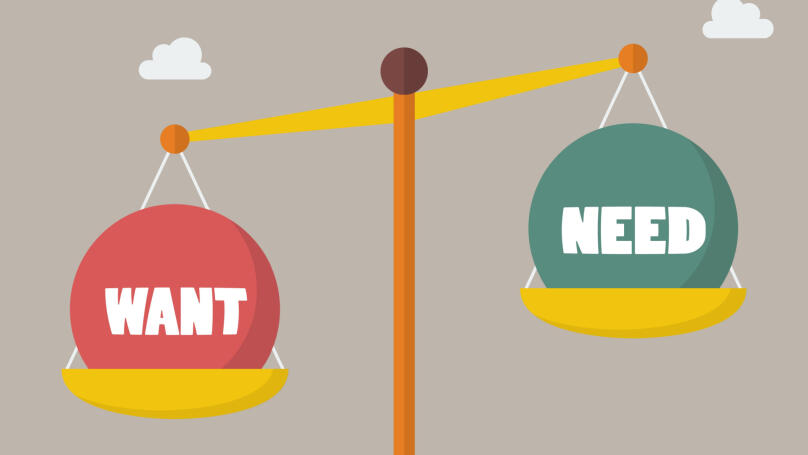Customer needs

What are customer needs?
A need is when someone requires a particular object or process. It represents a predicament or feeling. The fact is that having needs supports human life and helps us grow and flourish. Therefore, we might say that having certain needs motivates and drives us to achieve certain actions. Sometimes meeting customers' needs is essential for our existence and survival. This is the crucial difference between needs and wants.
Wants are defined as a conscious desire for something we do not have. However, we feel we cannot do without it. Someone's life or well-being is not dependent on what they want. You can determine whether you are experiencing a need and not a want from the following signs:
-
A person will experience increased distress if their needs remain unfulfilled. The discomfort will only pass after their needs have been met.
-
If a need is ignored over a long time, subconsciously, a person starts to seek any, even ridiculous, opportunities to meet it.
-
Needs dominate a person's mood, making them feel physically and mentally bad.
Likewise, a person may experience diverse needs simultaneously. At the same time, they are not equally important and not always related to one another.
Of course, directly in marketing, the actual definition of customer needs has a much narrower meaning: it could be any product or service that a potential customer needs and wants to feel fulfilled when they buy it. Suppose you are wondering why we should identify customer needs. In that case, the answer is that understanding needs enables you to:
-
Develop your marketing strategy and focus on a customer's more significant and relevant values;
-
Increase your customer base by having precise knowledge of your target audience;
-
Increase sales and customer loyalty;
-
Ensure trusting and long-term relationships with your audience;
-
Finally, this will also help you increase profits because everyone wants a product that solves real problems and their circumstances.
This is why knowing your audience's needs is critical for business development and increasing sales. First, a company must establish what is behind a desire to buy a product: what their customers' real needs resemble. After all, they can be quite different!
Types of customer needs

There are different categories of human needs and the needs of potential customers. The most well-known and popular among them is the Abraham Maslow theory.
In the 1940s, the American psychologist published an article, "A Theory of Human Motivation." Abraham Maslow suggested that human behaviour is identified by a hierarchy of needs. According to his theory, there are five levels in succession which represent human needs:
-
Physiology. The first level of needs concerns air, sleep, food, and water, which are necessary for human survival. Maslow considered these our fundamental basic needs because no one can survive without having all of them. In addition, until their physiological needs are met, a person will be unlikely to have other needs.
-
Security is the need to protect ourselves from external threats. In other words, when a person has provided themselves with ideal circumstances necessary to continue their existence, they strive to ensure the stability and security of their own life. This can include protection against natural threats and social and financial security.
-
Love and belonging. Similarly, these are also social needs because they involve communication with others, friendships, and building family ties. Whenever people ensure their safety, they can pay attention to others and want to build relationships, experience love, feel secure, and belong to social groups.
-
Respect and recognition. This is the need to be recognised by society as a whole. However, this alone is not enough because a person wants to feel important not only in the eyes of others but also in their own eyes. Therefore, this level of need also includes self-respect, self-acceptance, and personal values.
-
Self-expression. The highest level of needs involves divine and spiritual desires, such as self-actualisation, developing one's potential and talents, and the search for the meaning of life.
However, since its inception, Maslow's theory has been criticised. This relates to the main viewpoints of his theory. Suppose a person cannot achieve their basic needs for decent food and a comfortable living place. In that case, they will not try to fulfil their creative potential. However, this statement has too many exceptions, so it cannot be considered valid. History has numerous examples of individuals who had not achieved most of their basic needs, which motivated them to succeed and prove their worth in society. Likewise, at the same time, not every person who has achieved their basic needs seeks recognition in the community or wants family relationships. Also, Maslow's theory ignores cultural differences in an attempt to systematise and pigeonhole most people and put them into the same box. However, in defence of the psychologist, it has to be said that he nonetheless allowed exceptions, attributing them to a person's personality or external circumstances.
Many professionals now use more modern and versatile categories than Maslow's pyramid of needs. For example, from a sales perspective, the following needs are highlighted:
-
Security
-
Comfort
-
Reliability
-
Status
-
Innovation
The first three needs from this classification may be referred to as rational or functional, ensuring a person's existence and supporting physical and mental health. In this case, a product's technical features and functions are important for quick, high-quality satisfaction and fulfilling customers' needs. For example, buying a warm jacket in winter, repairing a car, eco-friendly products for a healthy diet, quality medicines, etc.
The last two needs are considered to be emotional. They satisfy higher spiritual needs by reflecting a person's worldview, social status, and income level. For example, watches from the Swiss company Rolex or the latest brand of iPhone from Apple. People often feel more confident and influential after buying these expensive items.
There is another classification similar to the previous one:
-
Internal needs. They relate to the customers' individual experiences, complexes, and fears. For example, many women buy and use cosmetics to make themselves happier.
-
External needs are mediated by the desire to receive social recognition, to be valued on merit, and to become involved in any group. Interestingly, the example of buying cosmetics is also relevant for external needs because many women put on makeup to look good when they go out in public.
Needs can also be categorised as follows:
-
Hidden needs. In this case, the potential customer is aware of their need. However, they wouldn't fulfil it until they experience some inconvenience or discomfort.
-
Visible needs. These needs clearly concern the customer, so they must be met first. For example, the failure of household items, e.g., a refrigerator.
Additionally, there are related and unrelated needs. The former can be defined as a chain of needs; as soon as one need is secured, another emerges. This means that such needs appear after purchasing other goods. For example, when buying a new smartphone, a customer will want to purchase a charger, case, or headphones. Unrelated needs are usually specific products requiring no extra purchases.
How to identify customer needs

To identify the needs of potential customers, you can use the following methods that work best when they are combined together:
1. Focus groups
This is the name of qualitative research methods involving group interviews with target audience members for a particular product or an entire brand. This method best achieves an unbiased and objective opinion about a specific product or service. You should choose the right members for a portrait of the target audience. Therefore, they must have similar interests, hobbies, or other criteria, such as age, social status, and income level. It is equally important that none of the participants taking part in the discussion knows each other personally, as this may negatively affect the result.
2. Customer surveys
The primary benefit of this approach is having direct contact with your customers. By asking questions and observing consumer reactions, you can discover everything they need and their fears, doubts, and problems. Likewise, surveys may be conducted in various formats. For example, it could be calling potential and regular customers.
There are also social media and email surveys, polls, and tests. Any information-gathering should be conducted qualitatively because questions can reveal your customers' true needs only if they are asked the right questions at the right time. Therefore, consider every question when working with your audience; including these surveys in a sales strategy is vital. And the questions can be both open (that is, replying with not just a "yes" or "no" but with fully detailed answers) and closed (that help to ensure that the manager has properly understood the customer). There are also leading and clarifying questions that enable you to maintain dialogue and control over the conversation. It would be better if you could also use hypothetical questions that ask the customer to think about the future and alternative questions that offer a choice of options specifically based on the parameters of a product.
The most appropriate questions to ask a customer to determine their needs are as follows:
-
What service are you interested in?
-
What is the first thing you notice when buying a certain product?
-
What is your purpose for choosing a product?
-
Are you picking a product for yourself, or will it be a gift?
-
Have you used a similar product before?
-
Do you have particular preferences regarding product features - colour, model, etc?
-
What budget do you have?
-
Are you familiar with our product range?
-
Can I offer you an alternative option?
-
Which of the options suggested do you like best?
-
How do you prefer to pay: now or in instalments?
Remember that you must not ask all these questions in a row and ignore the other person's opinion, turning the conversation into an interrogation. Try to be genuinely interested in the customer's problem and show concern and desire to solve the difficulties encountered as quickly and efficiently as possible. At the same time, keep in mind that the main task of the survey is to obtain as much detailed information as possible.
3. Reviews on the company's website, social media and special platforms
Studying thematic forums and communities on social media with the largest number of subscribers is vital. Similarly, customers often leave comments about the product they bought on a company's official social media, marketplaces, etc. It is there, using anonymity, that many users honestly express their opinion about a particular product. Therefore, by looking at these websites, you can discover valuable criticism, weaknesses in your customer service and maintenance, issues not obvious to product manufacturers, and other customer problems. To do this, look carefully at the comments, questions, and reviews.
Additionally, they can be tracked on special Q&A services. These are another source for analysing the needs and identifying customer problems. For example, one of the most popular opinion exchange services is the Quora platform.
4. Search queries
Studying the most popular search queries is considered to be an equally effective method of discovering customer needs. The information users search for online will help you discover what fears, doubts and questions regarding the company's products are troubling them. Thanks to this information, you can create an offer relevant to your customers, which will be useful and in demand later.
This is a particular marketing tool for visualising the interaction experience between a customer and a company. This map reproduces in detail the path the consumer takes from realising their need to purchasing the right product. This enables you to look at the brand through your customers' eyes and understand their goals, motives, financial habits, and fears. Furthermore, a detailed analysis of your target audience helps you identify what actions need to be taken at each stage of interaction so that the customer's needs are met, and they will return to the company's services. In other words, it gives you a broad view of your audience's life and allows you to predict their most likely needs. Therefore, these maps are best used to create a development strategy for a new product that will anticipate and satisfy the needs of customers that have not yet arisen.
6. Market research
It is just as important to understand the current situation in the market and get to know your competitors, their plans, strategies and implemented innovations. You must regularly review and analyse competitor companies' advertising offers, social media posts, websites, and landing pages. Subsequently, you should conduct a detailed analysis. Discover the advantages and disadvantages of competitors and what problems their advertising focuses on. Likewise, also study the reviews and comments about products from similar companies. All these things will allow you to identify the needs of your potential customers that competitors could not meet.
7. Analysing customer behaviour
In addition to the fact that potential customers of a company or a particular product should be segmented according to key characteristics, such as gender and age, place of residence, interests and hobbies, social status and income level, the behaviour of members of each consumer group should also be observed. It is necessary to establish their financial habits, fears, psychological characteristics, requests, and product requirements. Their most common needs should be identified.
Therefore, identifying customer needs can be an effective marketing tool that enables you to rapidly increase sales whilst building long-term and trusting relationships with your customers. It is important to note that customers should not be forced to buy certain products or neglect their opinion and experience. You need to take care of your customers, search for an individual personalised approach to them, anticipate their needs and strive to meet them as effectively as possible. In this case, knowing about all your customer needs will enable your company to improve the quality of products and services, develop more effective marketing strategies to meet specific needs, respond quickly to changes and adapt to market conditions, increase competitiveness, and attract new audiences.























